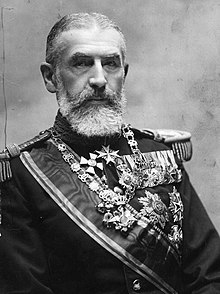
Back Carol I van Roemenië Afrikaans Carl I Rumǣnie Cyning ANG كارول الأول Arabic كارول الاول ARZ I Karol (Rumıniya kralı) Azerbaijani بیرینجی کارل (رومانی) AZB Караль I Byelorussian Карол I Bulgarian Carol Iañ Breton Carles I de Romania Catalan
| Carol I | |||||
|---|---|---|---|---|---|
 Carol I, c. 1905-14 | |||||
| King of Romania | |||||
| Reign | 15 March 1881 – 10 October 1914 | ||||
| Coronation | 10 May 1881 | ||||
| Predecessor | Monarchy established | ||||
| Successor | Ferdinand I | ||||
| Domn of Romania | |||||
| Reign | 20 April 1866 – 14 March 1881 | ||||
| Predecessor | Alexandru Ioan Cuza | ||||
| Successor | Himself as King of Romania | ||||
| Born | 20 April 1839 Sigmaringen Castle, Sigmaringen, Hohenzollern-Sigmaringen, German Confederation | ||||
| Died | 10 October 1914 (aged 75) Peleș Castle, Sinaia, Kingdom of Romania | ||||
| Burial | Curtea de Argeș, Romania | ||||
| Spouse | |||||
| Issue | Princess Maria | ||||
| |||||
| House | Hohenzollern-Sigmaringen | ||||
| Father | Karl Anton, Prince of Hohenzollern | ||||
| Mother | Princess Josephine of Baden | ||||
| Religion | Roman Catholic | ||||
| Signature |  | ||||
Carol I or Charles I of Romania (born Karl Eitel Friedrich Zephyrinus Ludwig von Hohenzollern-Sigmaringen; 20 April 1839 – 10 October [O.S. 27 September] 1914), was the monarch of Romania from 1866 to his death in 1914, ruling as Prince (Domnitor) from 1866 to 1881, and as King from 1881 to 1914. He was elected Prince of the Romanian United Principalities on 20 April 1866 after the overthrow of Alexandru Ioan Cuza by a palace coup d'état. In May 1877, Romania was proclaimed an independent and sovereign nation. The defeat of the Ottoman Empire (1878) in the Russo-Turkish War secured Romanian independence, and he was proclaimed King on 26 March [O.S. 14 March] 1881. He was the first ruler of the Hohenzollern-Sigmaringen dynasty, which ruled the country until the proclamation of a socialist republic in 1947.
During his reign, Carol I personally led Romanian troops during the Russo-Turkish War and assumed command of the Russo/Romanian army during the siege of Plevna. The country achieved internationally recognized independence via the Treaty of Berlin, 1878 and acquired Southern Dobruja from Bulgaria in 1913. In 1883 the king entered a top-secret military alliance with the Austro-Hungarian Empire, despite popular demands against Hungary. When World War I broke out he was unable to activate the alliance. Romania remained neutral and in 1916 joined the Allies.
Domestic political life was organized around the rival Liberal and Conservative parties. During Carol's reign, Romania's industry and infrastructure were much improved, however this process also resulted in major scandals, including the Strousberg Affair which personally implicated Carol. Overall, the country still had an agrarian-focused economy and the situation of the peasantry failed to improve, leading to a major revolt in 1907, bloodily suppressed by the authorities.
He married Princess Elisabeth of Wied on 15 November 1869. They only had one daughter, Maria, who died at the age of four. Carol never produced a male heir, leaving his elder brother Leopold next in line to the throne. In October 1880 Leopold renounced his right of succession in favour of his son William, who in turn surrendered his claim six years later in favour of his younger brother, the future King Ferdinand.